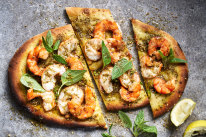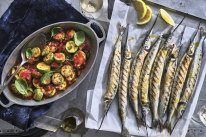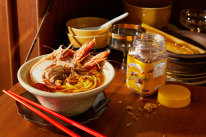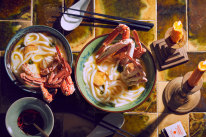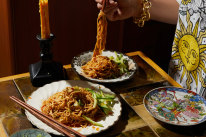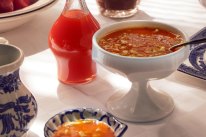Rosheen Kaul's barbecued sambal snapper
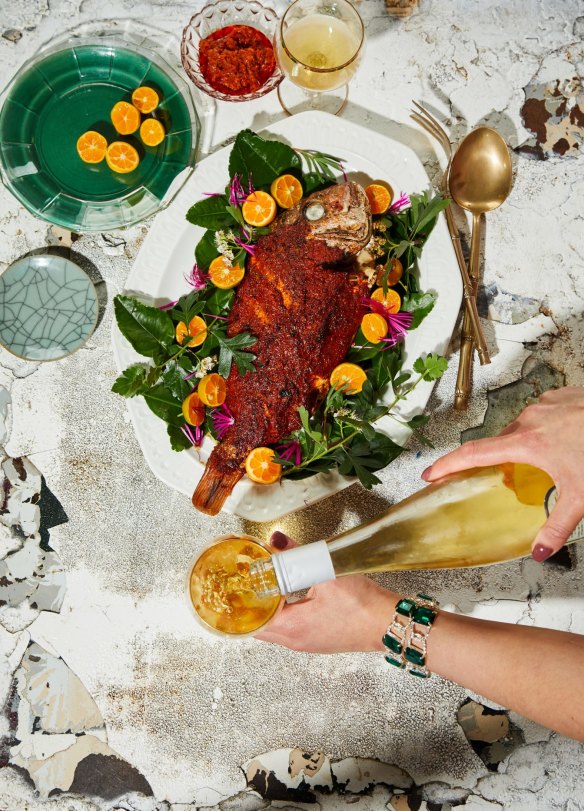
Sambal is a chilli paste of Indonesian origin that takes many delicious forms across the archipelago. The chillies can be dried or fresh – dried giving a most desirable deep red colour – and the sambal can be cooked or raw. This recipe calls for a tasty sambal tumis (stir-fry) of chillies, shallots, lemongrass and garlic. It can be served as a dipping sauce for vegetables, an accompaniment to fried dishes or slathered over grilled seafood.
Ingredients
1 whole baby snapper*, cleaned
75g dried chillies, rehydrated in warm water for 10-15 mins
25g long red chillies
100g shallots, peeled
5 cloves garlic, peeled
2 stalks lemongrass, white part only
20g shrimp paste, roasted
¼ tsp ground turmeric
250ml vegetable oil
30g tamarind paste
50g palm sugar
1 tsp salt
2 banana leaves** (optional)
Method
1. Toast the shrimp paste in a frying pan, stirring constantly over low heat until dry and powdery. Alternatively, wrap in aluminium foil and roast in the oven at 180C for 10-15 minutes. Place the roasted shrimp paste, rehydrated dried chillies, fresh red chillies, shallots, garlic, lemongrass and turmeric in a food processor with 50ml of the vegetable oil and blitz to a fine paste.
2. Heat the remaining oil in a wok or frying pan over medium heat, and when the oil is hot add the raw sambal paste.
3. Stir-fry continuously over medium-low heat until the colour deepens to a dark red. Add more oil progressively if it begins to dry out. The most important thing to do here is taste! The flavour should be deep and roasty without any bite of raw chilli or garlic. Keep cooking until there's a wonderful depth of flavour. When the sambal is ready, a layer of red oil will have separated from the paste. Add the tamarind paste, palm sugar and salt, stir to combine and remove from the heat. Adjust the seasoning to taste.
5. Ensure the fish is entirely clean of scales, pat dry with paper towel and and carefully score two deep diagonal slashes on either side.
6. Place your banana leaf (if using, see tip for alternatives) shiny side up, and spread a layer of sambal on the leaf for the fish to rest on.
7. Place the fish on the sambal, then using a pair of gloved hands, spread more of the sambal generously over the fish and inside the cavity. Set the rest of the sambal aside to serve.
8. Cover with another banana leaf and use toothpicks to secure the edges.
9. Place fish on a preheated grill and cook for 10-15 minutes on each side, turning once. You want to char through the banana leaf slightly. If you're using foil, open it up and place the fish under the grill towards the end of the cooking process to get some char.
10. Serve with more sambal, steamed rice and plenty of fresh lime wedges. Eat immediately with a squeeze of lime.
*I am using baby snapper here, but you can also use fish fillets if you prefer.
**Tip: Wrapping the fish in banana leaves (available at most Asian grocers) before grilling imparts a wonderful fragrance and gives abeautiful charred effect. But you can also wrap the fish in baking paper, then foil, if it's more convenient.
This recipe features in Rosheen Kaul's South-East Asian Christmas menu
Appears in these collections
The best recipes from Australia's leading chefs straight to your inbox.
Sign up- More:
- Seafood
- Sauces & dressings
- Barbecue
- Banquet
- Main course
- Summer barbecue
- Dinner party
- Fish
- Chilli
- Asian
- Summer
- Entertaining
From our partners
Similar Recipes

This banh mi with a delicious difference takes just 10 minutes to make at home
- < 30 mins
- Jessica Brook

Julia Busuttil Nishimura’s go-to midweek fish with tomatoes, harissa and fennel
- 30 mins - 1 hr
- Julia Busuttil Nishimura

